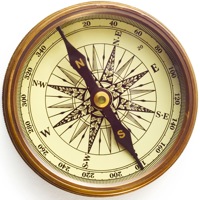Difference between revisions of "Compass"
m (Text replacement - "http://" to "https://") |
|||
| Line 1: | Line 1: | ||
[[File:lighterstill.jpg]][[File:Compass2.jpg|right|frame]] | [[File:lighterstill.jpg]][[File:Compass2.jpg|right|frame]] | ||
| − | *Date: [ | + | *Date: [https://www.wikipedia.org/wiki/14th_Century 14th century] |
==Definitions== | ==Definitions== | ||
*1 a : [[boundary]], [[circumference]] <within the compass of the city walls> | *1 a : [[boundary]], [[circumference]] <within the compass of the city walls> | ||
| Line 12: | Line 12: | ||
*4 : direction 6c <his [[moral]] compass> | *4 : direction 6c <his [[moral]] compass> | ||
==Descriptions== | ==Descriptions== | ||
| − | A '''compass''' is a [[navigational]] [[instrument]] for determining direction [[relative]] to the [[Earth]]'s [ | + | A '''compass''' is a [[navigational]] [[instrument]] for determining direction [[relative]] to the [[Earth]]'s [https://en.wikipedia.org/wiki/Magnetic_pole magnetic poles]. It consists of a magnetized pointer (usually marked on the North end) free to align itself with [[Earth]]'s [https://en.wikipedia.org/wiki/Earth%27s_magnetic_field magnetic field]. The compass greatly improved the safety and efficiency of [[travel]], especially [[ocean]] travel. A compass can be used to [[calculate]] heading, used with a sextant to calculate [https://en.wikipedia.org/wiki/Latitude latitude], and with a [https://en.wikipedia.org/wiki/Marine_chronometer marine chronometer] to calculate [https://en.wikipedia.org/wiki/Longitude longitude]. It thus provides a much improved [[navigational ]] [[capability]] that has only been recently supplanted by modern devices such as the [https://en.wikipedia.org/wiki/Global_Positioning_System Global Positioning System (GPS)]. A compass is any [[magnetically]] [[sensitive]] device capable of indicating the direction of the [https://en.wikipedia.org/wiki/North_Magnetic_Pole magnetic north] of a [[planet]]'s [https://en.wikipedia.org/wiki/Magnetosphere magnetosphere]. The face of the compass generally highlights the [https://en.wikipedia.org/wiki/Cardinal_direction cardinal points] of north, south, east and west. Often, compasses are built as a stand alone sealed [[instrument]] with a magnetized bar or needle turning freely upon a pivot, or moving in a [[fluid]], thus able to point in a northerly and southerly direction. The compass was [[invented]] in [https://en.wikipedia.org/wiki/Ancient_China ancient China] sometime before the 2nd century, and was used for [[navigation]] by the 11th century. The dry compass was [[invented]] in [https://en.wikipedia.org/wiki/Middle_Ages medieval] Europe around 1300. This was supplanted in the early 20th century by the liquid-filled magnetic compass. |
| − | Other, more accurate, devices have been [[invented]] for determining north that do not depend on the Earth's magnetic field for operation (known in such cases as [ | + | Other, more accurate, devices have been [[invented]] for determining north that do not depend on the Earth's magnetic field for operation (known in such cases as [https://en.wikipedia.org/wiki/True_north true north], as opposed to [https://en.wikipedia.org/wiki/Magnetic_north magnetic north]). A [https://en.wikipedia.org/wiki/Gyrocompass gyrocompass] or [https://en.wikipedia.org/wiki/Astrocompass astrocompass] can be used to find true north, while being unaffected by stray [[magnetic]] fields, nearby [[electrical]] [[power]] [[circuits]] or nearby masses of ferrous metals. A recent [[development]] is the electronic compass, or [https://en.wikipedia.org/wiki/Fibre_optic_gyrocompass fibre optic gyrocompass], which detects the [[magnetic]] directions without [[potentially]] [[fallible]] moving parts. This device frequently appears as an [[optional]] subsystem built into GPS receivers. However, magnetic compasses remain popular, especially in remote areas, as they are cheap, durable, and require no electrical power supply.[https://en.wikipedia.org/wiki/Compass] |
[[Category: General Reference]] | [[Category: General Reference]] | ||
Latest revision as of 23:42, 12 December 2020
- Date: 14th century
Definitions
- 1 a : boundary, circumference <within the compass of the city walls>
- b : a circumscribed space <within the narrow compass of 21 pages — V. L. Parrington>
- c : range, scope <the compass of my voice>
- 2 : a curved or roundabout course <a compass of seven days' journey — 2 Kings 3:9
- 3 a : a device for determining directions by means of a magnetic needle or group of needles turning freely on a pivot and pointing to the magnetic north
- b : any of various nonmagnetic devices that indicate direction
- c : an instrument for describing circles or transferring measurements that consists of two pointed branches joined at the top by a pivot —usually used in plural —called also pair of compasses
- 4 : direction 6c <his moral compass>
Descriptions
A compass is a navigational instrument for determining direction relative to the Earth's magnetic poles. It consists of a magnetized pointer (usually marked on the North end) free to align itself with Earth's magnetic field. The compass greatly improved the safety and efficiency of travel, especially ocean travel. A compass can be used to calculate heading, used with a sextant to calculate latitude, and with a marine chronometer to calculate longitude. It thus provides a much improved navigational capability that has only been recently supplanted by modern devices such as the Global Positioning System (GPS). A compass is any magnetically sensitive device capable of indicating the direction of the magnetic north of a planet's magnetosphere. The face of the compass generally highlights the cardinal points of north, south, east and west. Often, compasses are built as a stand alone sealed instrument with a magnetized bar or needle turning freely upon a pivot, or moving in a fluid, thus able to point in a northerly and southerly direction. The compass was invented in ancient China sometime before the 2nd century, and was used for navigation by the 11th century. The dry compass was invented in medieval Europe around 1300. This was supplanted in the early 20th century by the liquid-filled magnetic compass.
Other, more accurate, devices have been invented for determining north that do not depend on the Earth's magnetic field for operation (known in such cases as true north, as opposed to magnetic north). A gyrocompass or astrocompass can be used to find true north, while being unaffected by stray magnetic fields, nearby electrical power circuits or nearby masses of ferrous metals. A recent development is the electronic compass, or fibre optic gyrocompass, which detects the magnetic directions without potentially fallible moving parts. This device frequently appears as an optional subsystem built into GPS receivers. However, magnetic compasses remain popular, especially in remote areas, as they are cheap, durable, and require no electrical power supply.[1]
